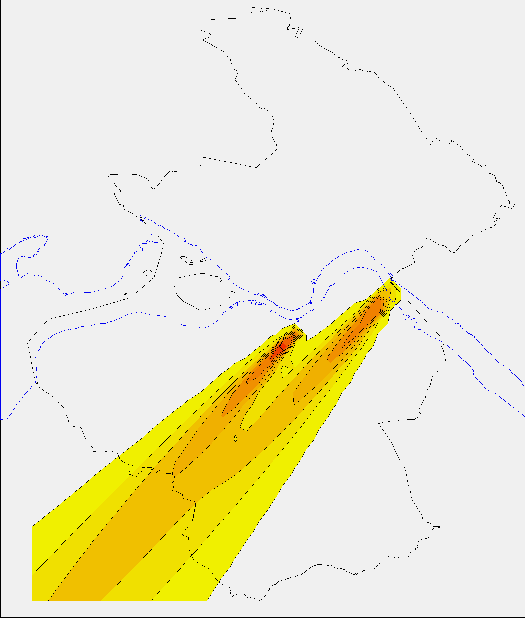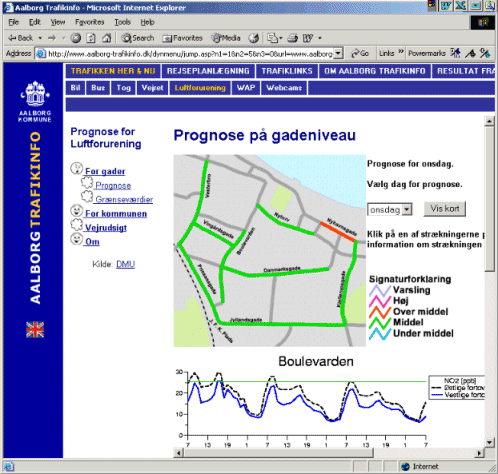Contents
Since 1996, the National Environmental Research Institute (now integrated in Aarhus University, Denmark), Denmark, has developed a comprehensive and unique integrated air pollution model system, THOR. The model system includes several meteorological and air pollution models capable of operating for different applications and different scales. The system is capable of accurate and high resolution three-days forecasting of weather and air pollution from regional scale over urban background s
cale and down to individual street canyons in cities - on both sides of the streets. Coupling models over different scales makes it possible to account for contributions from local, near-local as well as remote emission sources in order to describe the air quality at a specific location - e.g. in a street canyon or in a park. The system is used in connection with the urban and background monitoring programs in Denmark. Furthermore, the system can be used to forecast air pollution from accidental releases as e.g. power plants, industrial sites and natural or human made fires.
The main purposes of the THOR system are forecasting, nowcasting, emission reduction scenarios, retrospective analyses and air pollution assessments and management. The system can be used for information and warning of the public in cases of high air pollution levels and for policy management (e.g. by emission reduction or traffic scenarios) of many different chemical compounds. The system can be applied operationally for any location all over the world. The system consists of several different air pollution models - all developed at NERI during the last decades. A schematic diagram of the different modules and the data flow chart of the THOR system is shown in the figure below. The model system consists of a coupling of several models, briefly described in the following.

Present capabilities of the THOR system include all aspects within forecasting, nowcasting, supplement to monitoring programs, scenarios, retrospective analyses, assessment and management of air pollution. Some examples are:
A three-dimensional numerical weather forecast model, Eta, is applied. This model is initialized with data from a global circulation model, run at the National Centers for Environmental Prediction, NCEP, USA. Data from this global circulation model are the starting point for nearly all weather forecasts in the USA, and for many forecasts in Europe (e.g., Belgium, Greece, Yugoslavia and Iceland). The spatial resolution of the weather forecast model is e.g. 39 km x 39 km over the global grid and 10 km x 10 km over a sub-domain (see the two figures below for an example). Three-dimensional information on winds, temperature, humidity, clouds, precipitation, turbulent fluxes, radiation, etc. can be visualized e.g. every six hours as maps and e.g. every one hour as time series for specific locations. The figures below show the precipitation and surface pressure on November 12th, 2002 for Europe and Denmark.


The weather forecast is used as input to a long-range transport air pollution model, the Danish Eulerian Hemispheric Model, DEHM, producing air pollution forecasts on regional background scale (e.g. the greater European scale). The operational version of the model calculates transport, dispersion, deposition and chemistry (including photochemistry) of 56 chemical compounds. Furthermore, the model can be used to describe and forecast sand/dust storms. The emission data used in DEHM are derived from a combination of information provided by the European Monitoring and Evaluation Programme (EMEP) and global emission databases. The two figures below show concentrations of nitrogen-dioxide over Europe and Denmark on November 12th, 2002.


Meteorological data from the weather forecast and air pollution concentrations from the long-range transport model are subsequently used as input to the Urban Background Model, UBM, calculating the urban background air pollution based on emission inventories with a spatial resolution down to one kilometer. The model is e.g. run operationally for the central city of Copenhagen and for the city area of Aalborg, Denmark, and the results of these calculations are published on the Internet four times each day. The UBM model, in the version presently applied in Denmark, is suitable for calculations of urban background concentrations when the dominating source is the road traffic and/or large point sources. The two figures below show concentrations of nitrogen-dioxide over the city of Aalborg (upper figure) and the city of Copenhagen (lower figure).


The output from the urban background model is used as input to the Operational Street Pollution Model, OSPM, producing the air pollution concentrations at street level at both sides of the streets in cities. The model calculates air concentrations of NO, NO2, NOx, O3, CO and benzene in the street canyon at both sides of the street. Particles will be included in the model in the near future. The OSPM has been successfully tested under specific European field campaigns in a variety of different climatic and air quality conditions in, e.g., Copenhagen, Gothenburg, Helsinki, Oslo, Brussels, Berlin, Hanover, and Milano. It has also been tested and applied in Beijing, China, under a cooperation agreement with Tsinghua University.

Due to the circulation of air in street canyons (see the figure above), the air pollution concentrations can be very different at the two sides of a street. This is illustrated in the two sets of figures below. The upper set of figures show a three-day forecast of air pollution concentrations at the eastern and western side of a street in Copenhagen for different chemical compounds. Depending on the meteorological situation, the concentration levels are very different. In the lower set of figure, the maximum value of the two sides of the street is visualized as colored levels. Blue indicates concentrations below mean, green indicates mean concentrations, and red indicates air pollution concentrations above mean.

 -->
-->
In addition to urban air quality forecasting, the multi-point (plus area source) dispersion model, OML, has been integrated into the THOR system. This new feature is based on the coupling of the OML point and area dispersion model to the urban background model (UBM). The OML model is the standard model for routine regulatory applications according to the guidelines issued by the Danish Environmental Protection Agency. Thus, it is used for estimating the optimal heights of industrial stacks. OML is a local-scale operational air pollution model for estimating dispersion of a passive, or possibly buoyant, gas from strong point and area sources. It can be applied to distances up to approximately 30 km from the source. In the figure below, the air pollution from two distinct sources in the city of Aalborg is shown as an example.

Furthermore, the weather forecast drives the Danish Rimpuff and Eulerian Accidental release Model, DREAM, used in connection with accidental releases at greater scales as e.g. the Chernobyl accident. DREAM is a combined Lagrangian and Eulerian model, where the Lagrangian part handles the initial near-source transport and dispersion (up to ~300 km from the source) and the Eulerian part calculates transport and dispersion in an area covering e.g. Europe. The model can be used for any accidental release from power plants, industrial sites, natural and human made fires, etc. The first of the two figures below shows the radioactive concentrations of 137Cs, 10 days after the Chernobyl accident. The second figure shows the total deposition of 137Cs some weeks after the Chernobyl accident.


The entire THOR system is currently run operationally, up to four times every day, initiated with data at 00 UTC, 06 UTC, 12 UTC and 18 UTC. The system is fully automated - meaning that the entire procedure of receiving the data, running the models, producing the visualizations and sending the specified results to the end-users is controlled by automated procedures. The operational performance of the system is monitored every day. The whole system and the operational procedure have been run, tested and validated since August 1998.


Example of comparison of some model results with measurements as time series for January 2000 is given in the two figures above. The upper figure shows a comparison of hourly values of measured meteorological parameters in the city of Aalborg, Denmark, and the weather forecast. The lower figure shows a comparison of hourly values of measured concentrations and the air pollution forecast using the Operational Street Pollution Model at the street Vesterbro, Aalborg. As seen in the figures, the models produce very accurate forecasts of both weather and air pollution parameters.
All weather and air pollution data from the system can be disseminated to the authorities, decision-makers and the public. The raw data can be displayed as maps or as time series. Furthermore, information about exceedances of critical air pollution levels can be extracted and displayed as color codes or given as compressed information, as e.g. "below mean", "mean", "above mean", "high" or "warning". An example is given below for the inner city of Aalborg, Denmark. The home page (in Danish) displays the air pollution at ten streets in the city center, which are colored according to the five possible information levels described above. Furthermore, time series including the air pollution concentrations are given below the city map for detailed information.

Jørgen Brandt, PhD, Head of Section, Senior Scientist, Geophysicist
University of Aarhus, Department of Environmental Science
Frederiksborgvej 399, P.O.Box 358, DK-4000 Roskilde, Denmark
E-mail: jbr@dmu.dk
Phone: +45 8715 8522
Links